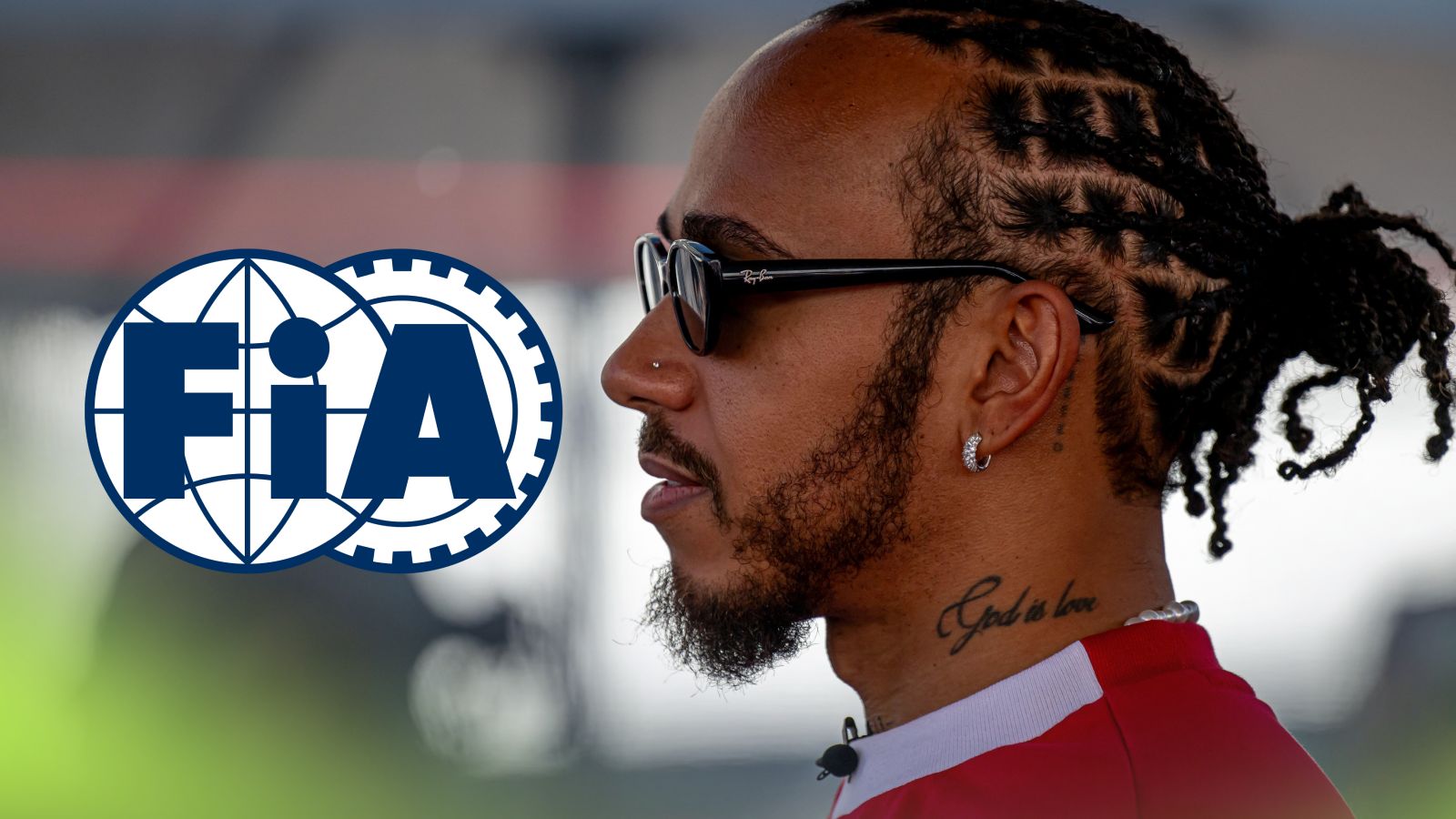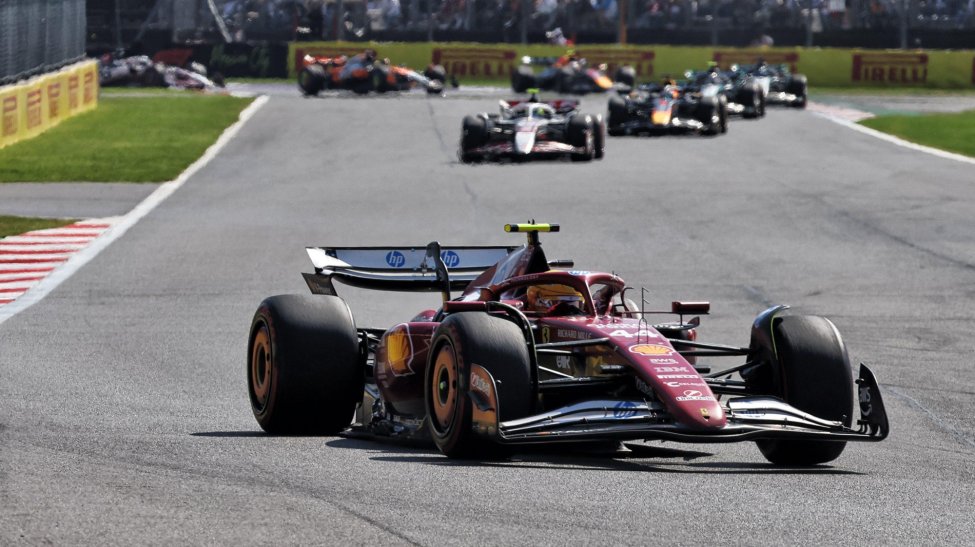Imagine the scene: a seven-time world champion, pushing a finely tuned Ferrari SF25 to its absolute limits, delivering a lap that promised redemption and a first real podium shot in a challenging season.
The car was “singing,” the garage was buzzing, and victory felt within reach. Then, a single, devastating 10-second penalty materialized, destroying everything, despite the sport’s own governing body admitting the driver “had no control over what happened.”
This is the core tragedy of the Mexican Grand Prix—a controversy so profound it has swept the paddock with outrage and ignited a furious debate among fans about the very survival and integrity of Formula 1.
The question lingering over the Autódromo Hermanos Rodríguez is chillingly simple: Can a global sport thrive when its own rulebook appears to contradict itself, punishing innocence with the severity of guilt?

The High-Altitude Collision: Physics, Instinct, and Chaos
The drama began as Lewis Hamilton, starting P3, found himself locked in a fierce, wheel-to-wheel dogfight with his perennial rival, Max Verstappen. The Mexican Grand Prix, already notorious for its demanding high-altitude conditions, was setting the stage for a classic duel. Verstappen, the “Predator refusing to yield,” lunged under braking for Turn 1, forcing Hamilton wide and momentarily sending both cars scrambling like gladiators unwilling to surrender.
But the real, race-defining drama unfolded at Turn 4.
Hamilton attempted to dive back inside, braking late and desperately trying to reclaim track position. Verstappen, defending with characteristic aggression, narrowed the gap to mere millimeters. In the milliseconds that followed, physics collided violently with human instinct. The front wheels of the Ferrari locked completely—a critical, terminal failure of grip that instantly rendered the steering input ineffective. The car went straight.
In that split-second, Hamilton faced an impossible choice: slam into the side of his rival and guarantee a catastrophic collision, or cut across the grass and rejoin the track ahead. He chose survival, navigating the escape route to avoid a crash, an action that inevitably took him outside the defined boundaries of the track.
From the cockpit, his frustration was clear, later shouting “Ridiculous.” But what he couldn’t have known was that the Stewards were already drafting the official documents that would extinguish his podium hopes.

The Contradictory Verdicts: Document 36 vs. Document 37
The penalty—a crushing 10-second sanction—was delivered in Document 36, citing that Hamilton “gained a lasting advantage.” Just like that, his meticulously executed race was deemed ruined, his hard-earned position nullified by the bureaucracy of the rulebook.
Yet, this ruling was instantly thrown into doubt by the startling inconsistency of prior events and, critically, the FIA’s own internal findings.
Telemetric evidence, later verified by Ferrari engineers, painted a clear picture: Hamilton lost time through turns five and six after rejoining, confirming no structural gain and no advantage was realized; it was purely a matter of self-preservation. Furthermore, the paddock was already boiling over the fact that Max Verstappen had executed the “exact same maneuver twice earlier without any penalty,” and other drivers had cut chicaines and rejoined with “zero repercussions, zero consistency, zero explanation.”
The real bombshell, however, was Document 37. Signed by the very stewards who issued the punishment, this contradictory document confirmed the undeniable truth: Hamilton’s actions were “physically unavoidable.” They acknowledged that brake lock, speed, and track conditions made the usual escape route impossible, and that Hamilton “had acted in good faith under circumstances beyond his control.”
The sport was left staring at two official FIA documents, released simultaneously, offering contradictory conclusions: one stating innocent and the other punishing him anyway. For fans, teams, and commentators, the logic had vanished entirely.
The Unforgiving Reality of High-Altitude Physics
To understand the full injustice, one must look to the physics of the Mexican circuit. The Autódromo Hermanos Rodríguez sits at 2,240 meters above sea level, a brutal altitude that fundamentally alters the racing environment. The thin air reduces brake cooling by over 30%, pushing the components to their limit, and simultaneously causes downforce to drop, severely compromising grip.
As Hamilton and Verstappen pushed their Ferrari and Red Bull machines together in these vanishingly small margins, the front wheels locking became a predictable, if devastating, outcome. Telemetry captured every millisecond to confirm that when the front wheels locked completely, the car went straight. “The escape route wasn’t optional. It was impossible to avoid,” the broadcast asserted. The engineers confirmed the penalty had nothing to do with performance; it was entirely about “the FIA’s control.”
The Explosive Reaction: A “Disgrace” and an Integrity Crisis
The reaction from the pit wall and the commentary booth was instantaneous and furious. Former F1 driver Sam Bird called the penalty “extremely harsh,” while Sky Sports commentators, typically measured in their criticism, admitted the ruling was “unnecessary interference in a natural racing battle.”
But it was Ferrari Team Principal Fred Vasseur, a man known for his calm diplomacy and patience, who finally cracked. His voice sharp with controlled fury, Vasseur denounced the decision as “Race destroying” with “no chance to recover.” He pointed directly to the hypocrisy: Max Verstappen had executed the same maneuver with “No consequences,” while Hamilton received 10 seconds. “Disgrace,” Vasseur declared, accusing the FIA of prioritizing “authority over fairness.” In that raw moment, Ferrari’s leadership felt they were being told that “rules exist to be enforced arbitrarily.”
The public reaction was explosive. Ferrari fans united in outrage. Italian newspapers ran headlines declaring injustice, while Spanish outlets condemned the decision as absurd. On social media, clips of Hamilton’s wheel lock went viral, fueling memes that depicted the FIA’s decision-making as sheer chaos with a rulebook. One viral post summarized the paddock’s fear: “If this can happen to Hamilton, imagine the rookies.”
The fury was not simply about points; it was about the fundamental trust, fairness, and credibility of the entire sport. This 10-second betrayal was a title race shifting moment. Every point mattered in the constructor’s battle against Mercedes and Red Bull, and an arbitrary penalty based on contradictory documents threatened to decide the fate of the entire season. The feeling across the Atlantic echoed the sentiment: if a seven-time champion can be “destroyed by bureaucracy, no one is safe.” The FIA, in the eyes of many, had just made politics “the ultimate overtaking move.”

Who Really Controls the Race?
As Hamilton walked back to the garage, helmet off and face grim, the disbelief among his team was palpable. Mechanics whispered, “If they can do this to a seventime champion.” Engineers, staring at the telemetry screens, had to face the reality that physics was on their driver’s side, but the rules were not.
The controversy has become a defining moment, not for speed or skill, but for the sport’s integrity. The thought that echoed across the paddock was damning: “Formula 1 isn’t just a sport anymore. It’s a chessboard of power, politics, and inconsistent enforcement.”
The aftermath presents three stark scenarios:
FIA Doubles Down:
-
- The governing body refuses to admit error, buries the controversy, and sets a dangerous precedent where drivers are punished for incidents beyond their control.
Ferrari Escalates:
-
- Ferrari lodges a formal protest, dissecting the documents, and forcing a scrutiny of every controversial decision of the last five years, causing F1 politics to explode.
The Quiet Fix:
- The FIA silently clarifies the rules without an apology, ensuring the event doesn’t happen again, while Ferrari accepts the loss because “fighting costs more than moving on.”
No matter the eventual path, one thing is certain: the next race could redefine everything. Will Hamilton reclaim his pace, or will politics continue to dictate results? This season, the consensus suggests, isn’t about who is fastest; it’s about “who survives the chaos.” Because if a driver with telemetry proving his innocence can be destroyed by 10 seconds, then nobody—no driver, no team, no fan—is truly safe. The haunting question remains: Has the FIA lost control of its own rule book, or was this exactly the message they wanted to send?